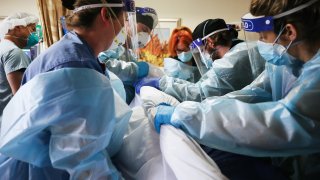
California Gov. Gavin Newsom’s administration and the state’s hospital association are at odds over how best to create space for critically ill coronavirus patients at already strained medical facilities that soon could be overwhelmed by the expected surge of new cases from holiday gatherings.
A surge following Halloween and Thanksgiving produced record hospitalizations and now the most seriously ill of those patients are dying in unprecedented numbers. California health authorities reported Thursday 583 new deaths and a record two-day total of 1,042.
The state has deployed 88 refrigerated trailers, up from 60 a few weeks ago, for use as makeshift morgues, mostly in hard-hit Southern California.
Hospitalizations are nearing 22,000 and state models project the number could reach 30,000 by Feb 1. Already, many hospitals in Los Angeles and other hard-hit areas are struggling to keep up and warned they may need to ration care as intensive care beds dwindle.
Earlier this week, state health officials caught hospitals off guard and left them scrambling with new orders limiting nonessential surgeries and requiring hospitals that have scarce ICU space to accept patients from those that have run out, an order that may require transferring patients hundreds of miles.
The California Hospital Association said the orders don’t go far enough to address a crisis that “cannot be overstated." It wants changes including reducing paperwork that it says is sapping hours daily from nurses who would otherwise be treating patients.
Carmela Coyle, the association’s president and chief executive, said the group has been negotiating with state officials but they aren’t acting fast enough.
Local
“We really need to move quickly to coordinate and see if we can eliminate the burden on the health care delivery system — focus on nothing other than saving lives for the next few weeks,” she said.
State epidemiologist Dr. Erica Pan responded Thursday that the administration is “committed to continuing to closely coordinate and partner with hospitals and local leaders.” She said state officials “appreciate any suggestions from those on the ground fighting this pandemic every day.”
Meantime, seeking to keep people closer to home, the Newsom administration issued a more strident travel advisory that says out-of-state residents are “strongly discouraged” from entering California, and Californians should avoid nonessential travel more than 120 miles (193 kilometers) from home.
The state’s advisory in November encouraged people to stay home or within their region without giving a specific number of miles. It outlined quarantine guidelines for out-of-state travelers but did not explicitly discourage travel.
Dr. Rajiv Bhatia, an affiliated assistant professor of medicine at Stanford University and a former director in the San Francisco Department of Public Health, questioned the effectiveness of a distance requirement, noting it will be difficult to enforce and people may tune out yet another piece of state guidance. He said California, broadly, hasn’t provided adequate data to back up restrictions.
“They simply don’t want to give anybody any opportunity to interact,” he said.
People traveling more than 120 miles are more likely to be accessing commercial services like hotels, said a spokesperson for the California Department of Public Health, noting the distance is designed to be fair for rural and urban residents.
Coyle said the orders affecting hospitals that were issued Tuesday don’t provide the help that hospitals desperately need.
Most hospitals affected by the nonessential surgeries order already canceled the sort of procedures barred by the state, like non-urgent spinal or carpal tunnel release surgeries, she said. It applies only to hospitals in 14 of 58 counties, all in Southern California and the agricultural San Joaquin Valley, two regions that have the most pronounced ICU bed shortage.
Coyle said it’s also unclear how often the transfer order will be used. While it could mean sending patients hundreds of miles to Northern California by ambulance, life flight helicopters or other aircraft, it’s more likely to ease transfers between nearby counties, she said.
During an earlier surge, patients in Imperial County along the border with Mexico were sent to hospitals as far as the San Francisco Bay Area. But the current outbreak is so widespread that only 11 mostly rural counties north of Sacramento and San Francisco are above the state’s threshold of having at least 15% capacity for coronavirus patients in ICU beds. Those below that level are under stricter restrictions for businesses.
UC Davis Health, which has the major trauma center in the Sacramento area, said it hasn’t received any transfer requests. A spokesman there and for the Sutter Health system both referred questions to the hospital association, while Kaiser Permanente did not immediately comment.
“If we can get patients in the right setting to begin with, it will minimize the need to have to transfer patients after the fact, and that’s just quite frankly better for patient care,” Coyle said.
That means California should start coordinating patient care at the state level where officials can see the big picture on best-equipped hospitals at any given moment, instead of allowing local dispatchers to follow the usual practice of sending ambulances to the nearest facility, she said.
“Yes, transferring patients is important but we have a number of big issues that need to be worked through,” she said. That includes temporarily suspending regulations that she said can tie up nurses on paperwork for hours and make it difficult to use a team approach to providing intensive care when hospitals lack sufficient critical-care-trained nurses.
California Nurses Association government relations director Stephanie Roberson said team nursing is a cost-cutting move that would undermine patient care after hospitals failed to properly prepare for the surge.
“It’s a slap in the face to safe patient care to actually call charting and documentation ‘red tape,’” she said.
Pan said the state's moves “will save lives” as officials look to get hospitals staff and resources.
State health officials did not respond to questions on how they expect the heath orders to be applied or how many patients or hospitals might be affected.
___
Associated Press writer Kathleen Ronayne in Sacramento, John Antczak and Christopher Weber in Los Angeles and Janie Har in San Francisco contributed to this story.



